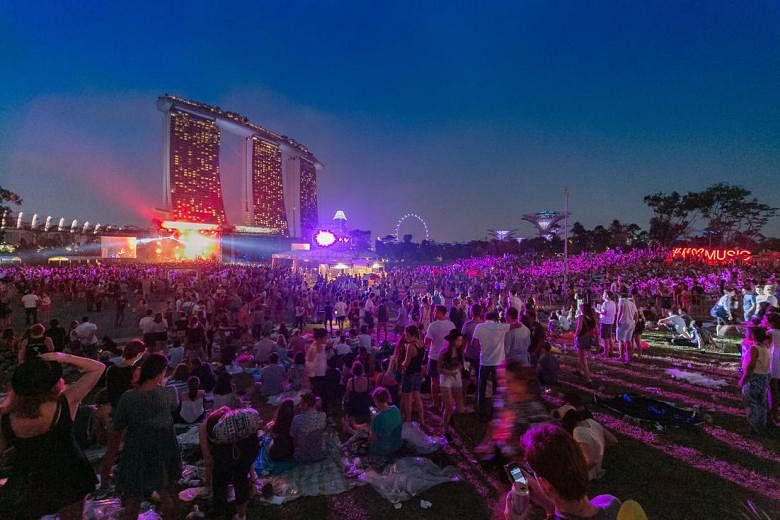It seems like there are plenty of music junkies here willing to stay cooped up in a confined space for up to 12 hours.
Despite online grumbling about a new "no re-entry" rule, popular indie music festival St Jerome's Laneway Festival Singapore drew a crowd similar to last year's 13,000 capacity audience - and many were already there when the first band, home-grown electronic-indie act Riot !n Magenta, kicked off the 12-hour festival in the scorching noon sun.
The early birds were ready to brave the elements, portaloos and festival-priced food and beverages to enjoy good music that went on all the way till midnight.
This was the first time that the festival, which has been held here annually since 2011, has implemented that rule.
The official line from the organisers in preventing paying punters from entering and exiting the festival as they please was for "safety and security". No further details were disclosed.
While no one wants to compromise on those issues, the question on everyone's lips is: Was there really no other way to ensure the safety and security of the audience without restricting their movements in and out of the festival?
Having attended plenty of music festivals and multi-act concerts, I have to say it can be irksome to be forced to stay within a venue.
There are plenty of reasons why a concertgoer would want to go in and out of a venue, especially for a day-long event - to look for alternative or cheaper food options, to freshen up, to stretch one's legs and go for a walk, among others.
Festivals are notorious for having pricey food -a meal and a drink at Laneway, for example, would cost about $20, more than double what you would pay at Texas Chicken, just a five-minute walk from the venue. Some fans I spoke to said they saved money by eating a huge brunch before entering the festival grounds at 11am, so that they could skip lunch and fork out money only for dinner.
While it didn't rain during this year's event, unlike the first Laneway at Fort Canning in 2011, the merciless sun did not let up until late afternoon.
There weren't many options for shelter either, unless you are headed to the White Room stage, the only one located in an air-conditioned tent.
The urge to go to Gardens by the Bay's air-conditioned eating area and chill out there was tempting, but that would mean having to leave the festival grounds.
With a festival like Laneway, with close to 30 acts playing on four stages, the beauty is that there are so many quality acts to choose from, not to mention the chance to discover gems you have not heard of before.
But the choice to come or go should be the ticketholder's.
There were certainly many non- music elements to keep fans occupied - enclosed areas selling festival and band merchandise, as well as accesories and clothes from fashion retailer H&M and everything else, ranging from a colouring contest to frolicking in an indoor ball pit.
Still, the venue at Gardens by the Bay's The Meadow was only about 22,000 sq m or the size of three football fields. That doesn't leave much space for festivalgoers to be comfortable, being packed in with 13,000 others.
At its peak, the fans on the field in front of the two main stages were packed like sardines.
Even if you were to move to the fringes, you would be, at best, 2m away from another group of fans.
While the "no re-entry" rule is not new in major festivals around the globe, the likes of marquee EDM event Ultra Music Festival in Miami and indie fest Pitchfork Music Festival in Chicago are held on much bigger grounds.
Ultra, for example, draws four times the number of Laneway Singapore's crowd each day and is held in a public park six times as large.
Electronic dance festival ZoukOut, Singapore's longest-lasting and one of the most prominent music-oriented events here with crowds up to 45,000 annually, does not have the "no re-entry" rule. New music and arts festival Neon Lights, which made its debut last November, allowed the audience to come and go as they pleased.
The three days of the annual Singapore Grand Prix draws some of the biggest crowds - up to 50,000 - for any music event held here at its Padang concerts. It, too, allows re-entry.
The big question is, will Laneway start a precedent and will other events follow? For one thing, enforcing a "no re-entry" rule would cut down security costs, as fewer staff are required to check and re-check festival goers.
Laneway attracts a primarily young adult and late teenage audience and these are certainly the demographic resilient enough to last 12 hours as long as there is good music to be had.
And while ZoukOut, too, attracts the same, young and hardy crowd, its organisers do not plan to have the "no re-entry" rule. It's an all-night event, from about 8pm to 8am, so there's no sun to worry about. Many of the revellers book hotels in Sentosa, where the festival is held, and not allowing them to zip in and out of their rooms would surely create a big stink.
The Singapore Grand Prix, unlike Laneway and ZoukOut, is a more family-friendly affair and it would be really difficult to imagine forcing those who come with children and the elderly to stay put in the Circuit Park without giving them the option to exit and re-enter if they needed to.
Gigs aren't getting any cheaper - the first Laneway here cost $99.50, compared to $180 at last Saturday's edition. And while the festival has tripled its line-up since then, it would be so much better if that expansion didn't include taking away festivalgoers' freedom to come and go as they please.


